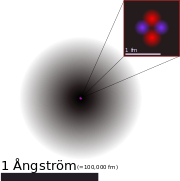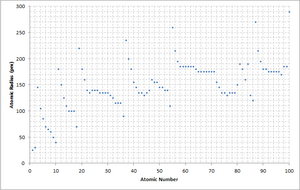نصف القطر الذري
نصف القطر الذري Atomic radius هو المسافة بين نواة الذرة إلى مدار الإلكترون الخارجي الثابت والموجود في حالة اتزان. وتقاس بوحدة بيكو متر أو أنجستروم.
كما يطلق نصف القطر التساهمي على نصف القطر الذري ( عند تكون روابطة تساهمية )، ونصف القطر اللافلزي في حالة العناصر اللافلزية، نصف القطر الفلزي في حالة العناصر الفلزية. وتقنيا فإن نصف القطر الذري هو نصف مسافة الاتزان بين ذرتين متجاورتين، ( واللتان ترتبطان معا برابطة تساهمية، أو يتواجدا بقرب بعضهما البعض في شكلل شبكة بللورية لأي عنصر.
ويكون نصف القطر التساهمي نصف المسافة بين نواتي نفس الذرات المترابطة مع بعضها البعض. ويكون نصف القطر التساهمي للعناصر التي لا ترتبط ذراتها مع بعضها البعض يمكن تقديرها بالربط بينها وبين نصف القطر في الجزيئات المختلفة. ويمكن تحديد نصف القطر الفلزي على أنه نصف المسافة بين أقرب ذرتين متجاورتين في الشكل البللوري.
ويزيد نصف القطر الذري في الجدول الدوري بإضافة أغفلة إلكترونية، ويقل من اليمين إلى اليسار بزيادة شحنة النواة ( أو عدد البروتونات ).
. . . . . . . . . . . . . . . . . . . . . . . . . . . . . . . . . . . . . . . . . . . . . . . . . . . . . . . . . . . . . . . . . . . . . . . . . . . . . . . . . . . . . . . . . . . . . . . . . . . . . . . . . . . . . . . . . . . . . . . . . . . . . . . . . . . . . . . . . . . . . . . . . . . . . . . . . . . . . . . . . . . . . . . .
Empirically measured atomic radius
The following table shows empirically measured covalent radii for the elements, as published by J. C. Slater in 1964.[1] The values are in picometers (pm or 1×10−12 m), with an accuracy of about 5 pm. The shade of the box ranges from red to yellow as the radius increases; gray indicates lack of data.
| Group (column) |
1 | 2 | 3 | 4 | 5 | 6 | 7 | 8 | 9 | 10 | 11 | 12 | 13 | 14 | 15 | 16 | 17 | 18 | |||
| Period (row) |
|||||||||||||||||||||
| 1 | H 25 |
He | |||||||||||||||||||
| 2 | Li 145 |
Be 105 |
B 85 |
C 70 |
N 65 |
O 60 |
F 50 |
Ne | |||||||||||||
| 3 | Na 180 |
Mg 150 |
Al 125 |
Si 110 |
P 100 |
S 100 |
Cl 100 |
Ar | |||||||||||||
| 4 | K 220 |
Ca 180 |
Sc 160 |
Ti 140 |
V 135 |
Cr 140 |
Mn 140 |
Fe 140 |
Co 135 |
Ni 135 |
Cu 135 |
Zn 135 |
Ga 130 |
Ge 125 |
As 115 |
Se 115 |
Br 115 |
Kr | |||
| 5 | Rb 235 |
Sr 200 |
Y 180 |
Zr 155 |
Nb 145 |
Mo 145 |
Tc 135 |
Ru 130 |
Rh 135 |
Pd 140 |
Ag 160 |
Cd 155 |
In 155 |
Sn 145 |
Sb 145 |
Te 140 |
I 140 |
Xe | |||
| 6 | Cs 260 |
Ba 215 |
* |
Lu 175 |
Hf 155 |
Ta 145 |
W 135 |
Re 135 |
Os 130 |
Ir 135 |
Pt 135 |
Au 135 |
Hg 150 |
Tl 190 |
Pb 180 |
Bi 160 |
Po 190 |
At |
Rn | ||
| 7 | Fr |
Ra 215 |
** |
Lr |
Rf |
Db |
Sg |
Bh |
Hs |
Mt |
Ds |
Rg |
Cn |
Nh |
Fl |
Mc |
Lv |
Ts |
Og | ||
| * |
La 195 |
Ce 185 |
Pr 185 |
Nd 185 |
Pm 185 |
Sm 185 |
Eu 185 |
Gd 180 |
Tb 175 |
Dy 175 |
Ho 175 |
Er 175 |
Tm 175 |
Yb 175 | |||||||
| ** |
Ac 195 |
Th 180 |
Pa 180 |
U 175 |
Np 175 |
Pu 175 |
Am 175 |
Cm |
Bk |
Cf |
Es |
Fm |
Md |
No | |||||||
Explanation of the general trends
d-block contraction
The d-block contraction is less pronounced than the lanthanide contraction but arises from a similar cause. In this case, it is the poor shielding capacity of the 3d-electrons which affects the atomic radii and chemistries of the elements immediately following the first row of the transition metals, from gallium (Z = 31) to bromine (Z = 35).[2]
Calculated atomic radius
The following table shows atomic radii computed from theoretical models, as published by Enrico Clementi and others in 1967.[3] The values are in picometres (pm).
| Group (column) |
1 | 2 | 3 | 4 | 5 | 6 | 7 | 8 | 9 | 10 | 11 | 12 | 13 | 14 | 15 | 16 | 17 | 18 | ||
| Period (row) |
||||||||||||||||||||
| 1 | H 53 |
He 31 | ||||||||||||||||||
| 2 | Li 167 |
Be 112 |
B 87 |
C 67 |
N 56 |
O 48 |
F 42 |
Ne 38 | ||||||||||||
| 3 | Na 190 |
Mg 145 |
Al 118 |
Si 111 |
P 98 |
S 88 |
Cl 79 |
Ar 71 | ||||||||||||
| 4 | K 243 |
Ca 194 |
Sc 184 |
Ti 176 |
V 171 |
Cr 166 |
Mn 161 |
Fe 156 |
Co 152 |
Ni 149 |
Cu 145 |
Zn 142 |
Ga 136 |
Ge 125 |
As 114 |
Se 103 |
Br 94 |
Kr 88 | ||
| 5 | Rb 265 |
Sr 219 |
Y 212 |
Zr 206 |
Nb 198 |
Mo 190 |
Tc 183 |
Ru 178 |
Rh 173 |
Pd 169 |
Ag 165 |
Cd 161 |
In 156 |
Sn 145 |
Sb 133 |
Te 123 |
I 115 |
Xe 108 | ||
| 6 | Cs 298 |
Ba 253 |
* |
Lu 217 |
Hf 208 |
Ta 200 |
W 193 |
Re 188 |
Os 185 |
Ir 180 |
Pt 177 |
Au 174 |
Hg 171 |
Tl 156 |
Pb 154 |
Bi 143 |
Po 135 |
At 127 |
Rn 120 | |
| 7 | Fr |
Ra |
** |
Lr |
Rf |
Db |
Sg |
Bh |
Hs |
Mt |
Ds |
Rg |
Cn |
Nh |
Fl |
Mc |
Lv |
Ts |
Og | |
| * |
La 226 |
Ce 210 |
Pr 247 |
Nd 206 |
Pm 205 |
Sm 238 |
Eu 231 |
Gd 233 |
Tb 225 |
Dy 228 |
Ho 226 |
Er 226 |
Tm 222 |
Yb 222 | ||||||
| ** |
Ac |
Th |
Pa |
U |
Np |
Pu |
Am |
Cm |
Bk |
Cf |
Es |
Fm |
Md |
No | ||||||
شاهد أيضا
- عدد ذري
- وزن ذري
- رابطة تساهمية
- Atomic radii of the elements (data page)
- Chemical bond
- Covalent radius
- Bond length
- Steric hindrance
- Kinetic diameter
ملاحظات
- Difference between empirical and calculated data: Empirical data means "originating in or based on observation or experience" or "relying on experience or observation alone often without due regard for system and theory data".[4] In other words, the data are measured through physical observation, and vetted by other experiments generating similar results. Calculated data, on the other hand, are derived from theoretical models. Such predictions are especially useful for elements whose radii cannot be measured experimentally (e.g. those that have not been discovered, or that have too short of a half-life).
المراجع
- ^ Slater, J. C. (1964). "Atomic Radii in Crystals". Journal of Chemical Physics. 41 (10): 3199–3205. Bibcode:1964JChPh..41.3199S. doi:10.1063/1.1725697.
- ^ خطأ استشهاد: وسم
<ref>غير صحيح؛ لا نص تم توفيره للمراجع المسماةJolly_contract - ^ Clementi, E.; Raimond, D. L.; Reinhardt, W. P. (1967). "Atomic Screening Constants from SCF Functions. II. Atoms with 37 to 86 Electrons". Journal of Chemical Physics. 47 (4): 1300–1307. Bibcode:1967JChPh..47.1300C. doi:10.1063/1.1712084.
- ^ "Definition of EMPIRICAL".


